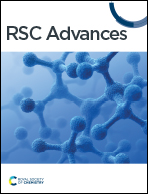Near-infrared active ferrocenyl porous organic polymer with photothermal enhanced enzymatic activity for combination antibacterial application†
Abstract
As a severe ongoing global problem, bacterial contamination exists in every aspect of human life and the search for new antibacterial agents is urgently needed. Herein, a ferrocenyl porous organic polymer (FMC-POP) broad-spectrum antibacterial agent based on synergistic photothermal and peroxidase-like activity was prepared in a facile manner via the copolymerization of ferrocene diformaldehyde and cinnamaldehyde with mannitol through the acid-responsive acetal bond. The photoactive FMC-POP, with high photothermal conversion efficiency (41.45%), could convert not only the near-infrared laser irradiation into local heat to eradicate bacteria, but also low-concentration H2O2 into radical oxygen species (˙OH) that are effective against bacteria. Compared with single-mode photothermal (PTT) and enzymatic therapies, this combination therapy could significantly improve the bactericidal effect, exhibiting a germicidal efficiency of up to 99% (vs. 80.42% for PTT and 70% for enzyme). Thus, our work paves the way for a synergistic non-invasive antimicrobial therapy, which could expand the applications of POP-based artificial enzymes in biomedicine.



 Please wait while we load your content...
Please wait while we load your content...